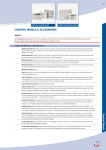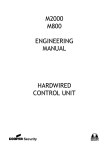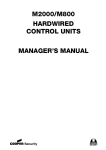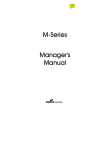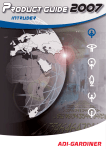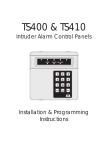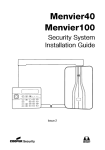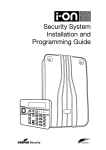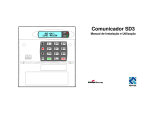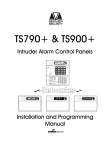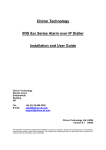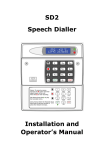Download Cooper Security M2000 Specifications
Transcript
M2000
Installation
Instructions
MENVIER
SECURITY
© Cooper Security Limited 2010
Every effort has been made to ensure that the
contents of this book are correct. However, neither the
authors nor Cooper Security Limited accept any
liability for loss or damage caused or alleged to be
caused directly or indirectly by this book. The contents
of this book are subject to change without notice.
Cooper Security Limited make every possible effort to
update manuals and guides regularly to reflect
changes in the product. If this document does not
reflect the function of the product please let us know.
You may be able to download a more recent version of
the document from our website:
www.coopersecurity.co.uk
Printed and published in the UK.
Cooper Security Ltd.,
Security House,
Vantage Point Business Village,
Mitcheldean,
Gloucestershire,
GL17 0SZ
England
Product Support (UK) Tel: +44 (0)1594 541979
Available between:
08:15-12:30 and 13:00-17:00 Monday to Friday.
Product Support Fax: +44 (0)1594 545401
Part Number 12049357
2
Contents
Introduction ................................................................................. 3 Fitting and Wiring Procedure ................................................ 6 General Wiring Considerations ............................................ 6 Cable Type .............................................................................. 6 Cable Segregation ............................................................... 6 Cables Routed inside the Control Panel ..................... 6 Initial Power-Up Procedure and Checks ........................... 6 Zone Wiring ................................................................................. 7 Anti-Masking Zone Connections ................................... 7 Network Connections .............................................................. 8 Network 1 and 2 Connections ........................................ 8 Telephone Connections .......................................................... 8 Approved Usage .................................................................. 9 Digital Communicator Outputs ............................................ 9 Transistor Outputs.................................................................. 10 Relay Outputs........................................................................... 11 External Bell/Sounder Connections ................................. 11 Auxiliary Tamper Input ......................................................... 11 Line Fault Input ........................................................................ 11 Communicator Line Fault .............................................. 11 Remote Reset Input ............................................................... 12 Extension Loudspeaker Connections .............................. 12 AC Input Connector ............................................................... 12 Battery Connector .................................................................. 12 12Vdc Auxiliary Power Terminals...................................... 12 Back Tamper Connector ....................................................... 12 Factory Restart Connector................................................... 12 Serial Printer Connector ....................................................... 13 Output Module Connector ................................................. 13 Engineer Keypad Connector ............................................... 13 Serial Connection to PC ....................................................... 13 Power Availability ................................................................... 14 Connecting to the Mains Supply ...................................... 14 LEDs ............................................................................................. 15 Polyfuses .................................................................................... 15 Electromagnetic Compatibility .......................................... 15 Technical Specifications ....................................................... 15 M2000 Installation Instructions
• Engineer keypad port.
Introduction
Figure 1 and Figure 2 show the layout of the control
panel and the main features of the printed-circuit
board (PCB).
The panel includes a wealth of features, including:
• Eight on-board zones.
• Two network ports for the connection of keypads,
MSNodes and MRNodes (see Figure 3). The
additional network devices enable the system to
be expanded up to 264 zones.
• Serial and USB connectors for local connection of a
PC running the Downloader configuration and
monitoring software.
• An on-board modem connected to PSTN and RJ11
ports to enable remote connection to a remote
alarm receiving centre or to a PC running the
Downloader software.
• Switched-positive, switched-negative and voltagefree programmable outputs.
• CPA6 output port to provide additional
programmable outputs.
• Serial printer port.
This leaflet describes how to install the control panel. If
you need a general overview of its features, please
refer to the M2000/M800/M750 Engineering Manual.
If you require details of how to install keypads or other
ancillary devices, please refer to their separate
installation instructions.
At the publication of this manual, the MKP1, CPA6,
MIDNode and IDNode are no longer available for sale.
This manual includes details of these products in case
you are fitting a M2000 control unit to older M-series
alarm systems with these products.
Note: Before connecting any external devices to the
control panel, make sure that it is able to provide
sufficient current to power such devices, as described
on page 14.
• 16-channel digital communicator outputs for
connection to an alarm receiving centre or to
provide additional programmable outputs.
Fixing hole (1 of 3)
Fused terminal block
Mains terminal block
Mains transformer
Back tamper
switch
mounting slots
0
Mains cable
entry ONLY
Battery
position
Printed circuit
board (PCB)
Fixing hole
(3 of 3)
Fixing hole
(2 of 3)
Figure 1: Control Panel Layout
M2000 Installation Instructions
3
23
24
5
25
SK1
16
A
B C/F D E/G
REMOTE NETWORK 2
PSTN
A1 B1
SK2
LED2
LED3
USB
22
LED4
6
9
PIN 1
LED1
Z2
T2
CIRCUIT 2
LED7
Z7
T7
CIRCUIT 7
17
LED12
LED13
Z8
T8
CIRCUIT 8
15
LED5
LED6
14
AC
IN
0V 0V 12V 12V
AUX
16
BATT
0v -3 +4 -5 12V
TRANSISTOR OUTPUTS
1
LED9 LED8
SERIAL
PRINTER
19
BACK
TAMPER
Z6
T6
CIRCUIT 6
FACTORY
RESTART
Z5
T5
CIRCUIT 5
18
+
0V REM LINE
TRG STB TR- H/O H/O N/O N/C COM N/O N/C COM
RELAY1
RELAY2
- BELL +
SPKR RST FLT AUX TMP -
LED10
0V
1
14V4
Z4
T4
CIRCUIT 4
LED14 LED11
OUTPUT
MODULE
Z3
T3
CIRCUIT 3
PIN 1
20
2
3
4
5
6
7
DIGITAL COMMUNICATOR
8
ENGINEERS
KEYPAD
Z1
T1
CIRCUIT 1
21
10 11 12 13 14 15
DIGITAL COMMUNICATOR
B
4
A
A
B
C
D
E
REMOTE NETWORK 1
2
3
7
8
9
10
11
12
13
26
Figure 2: Control Panel PCB
Ref
1
2
3
4
5
6
7
8
9
10
11
12
13
14
4
Description
Zone connectors
Network 1 connector
Network 2 connector
PSTN (Telephone) terminals
RJ11 (Telephone) socket
Digital communicator outputs
Transistor outputs
Relay outputs
External bell/sounder connections
Auxiliary tamper input
Line fault input
Remote reset input
Extension loudspeaker connections
AC input connector
See Page
6
8
8
8
8
9
10
11
11
11
11
12
12
12
Ref
Description
15
Battery connector
16
12Vdc Auxiliary power terminals
17
Back tamper connector
18
Factory restart connector
19
Serial printer connector
20
Output module connector
21
Engineer keypad connector
22
USB connection to a PC
23
ADSL filter conector
24.
Serial (RS232) connection to a PC
25.
Connectors for 8600 Relay Card
26.
14.4V Siren output
LEDs 1-14
Polyfuses
See Page
12
12
12
12
13
13
13
13
8
13
10
11
15
15
M2000 Installation Instructions
Network 1
2000
CONTROL
PANEL
Wiring Option 1
MSNodes
Max 16
2 Outputs
100m max
MSNode
1
1 Output
100m max
8 Zones
Network 2
MRNode
2
MSPSU
16
8 Zones
1 km max
to furthest
MSNode
8 Zones
An MSNode/MSPSU is
capable of driving 4
Remote Keypads and
a Loudspeake r
NOTE:
Do not connect an MSPSU,
MSNode, or MRNode directly
to the same network as an
100m max to
MIDNode or keypad.
furthest keypad
Max 4
5 Outputs
8 Zones
Engineer’s keypad (cannot
have zones or outputs).
Note: When plugged in,
an engineer’s keypad is
connected to network 1.
This may interfere with the
corrrect function of any
attached MSPSU,
Wiring Option 2
Remote Keypads/LEC2s
1 Output
1 Output
Max 5
1 Output
1 Output
1 Output
100m max to
furthest
keypad/LEC2
MSNode, or MRNode
2 Zones
2 Zones
Network Wiring = 6 Core
Wiring Option 3
MIDNode/IDNode
2 Zones
2 Zones
2 Zones (see note
below)
8 Outputs
MIDNode/ID Node
30 ID Zones
Maximum of 120 zones
with four MIDNodes.
Maximum of 40 zones
with two IDNodes.
NOTE:
Do not connect an MSPSU,
MSNode, or MRNode directly
to the same network as an
MIDNode/IDNode.
Figure 3: Overview of Network Wiring Options
Note:
• Using a Networker Interface Board (NIB) (with power supply) enables the maximum distance from a control panel to an ID Node or keypad to be
increased to 1km.
• The supply voltage at each Network 1 or 2 device must not drop below 10.5V (Cooper Security recommend that for reliable working while mains power
is present you should ensure that the voltage at each device is above 12.0V). Refer to the M2000/M800/M750 Engineering Manual for details of how to
calculate and overcome voltage drops.
• Direct connection of an LEC6 (6-zone) expander to Network 1 or 2 is supported for existing systems that are being upgraded. Ensure that the number
of zones does not exceed the number that would be provided by keypads alone.
M2000 Installation Instructions
5
Fitting and Wiring Procedure
To install the control panel:
1.
Remove the front cover by releasing its three
retaining screws and disconnecting the earth
bonding cable from the spade connector on the
transformer.
Warning: mains voltages may be present at the
mains terminal block (see Figure 1).
2.
Connect any optional modules to the PCB.
3.
Slide the back tamper switch mounting plate into
the slots shown in Figure 1.
4.
Route all cables through the cable-entry holes
located on the base of the control panel. All holes
used must be fitted with a rubber grommet to
protect against sharp edges. The mains cable
must use its own cable-entry hole.
5.
If required, secure the control panel to a wall
using not less than 30mm x No 10 screws through
the three fixing holes shown in Figure 1.
6.
Connect all wiring except to the standby battery
(connect during power-up procedure).
The network and detection cables should be kept clear
of cables supplying sounders or extension
loudspeakers. It is also advisable to avoid running
more than one network down a single cable.
Cables Routed inside the Control Panel
Cables routed inside the product, must be:
• Kept as short as possible.
• Routed close to the housing.
• Kept as far as possible from the electronics.
Initial Power-Up Procedure and Checks
1.
Place a small screwdriver blade between the
FACTORY RESTART terminals ("18" on Figure 2).
When you switch on the mains, this will ensure
that the factory default settings are used, as
documented in the M2000/M800/M750
Engineering Manual.
2.
Switch on the mains supply and remove the
screwdriver blade only when the heartbeat LED
(LED1, next to the Digital Communicator
terminals) flashes. This may take up to 30 secs.
3.
Check that the power LED on the control panel
PCB is lit. The keypad sounders and extension
loudspeakers will operate (tamper alarm).
In general, the control panel requires standard 7/0.2
un-screened alarm cable for wiring to MSNodes,
MRNodes, keypads, LEC2s, ID Nodes and zone
sensors. The number of cores varies, depending on the
device being connected.
4.
Enter your engineer passcode (default 1234). The
sounders are silenced and the system prompts to
confirm the network devices used (as described in
the M2000/M800/M750 Engineering Manual).
Press [ESC] to enter the Engineering menus.
Screened cable may prove necessary if the installation
site has equipment that produces high levels of R.F.
(Radio Frequencies), e.g. heavy industrial plant such as
welding equipment, etc. If screened cable is required,
you should adhere to the following guidelines:
5.
Connect the standby battery.
6.
Switch off the 230V mains supply and ensure that
the DC voltage at each device on each network is
greater than 10.5V while the system is powered
from its standby battery.
1.
The screen on the cable should be connected only
to mains earth at the control panel to avoid earth
loops.
7.
Switch on the mains supply and measure the DC
voltage between the mains earth connection and
AUX +12V ("16" on Figure 2). Warning: Do not
2.
The continuity of the cable screen is most
important and screens MUST be continuous along
the full length of the network.
General Wiring Considerations
Cable Type
3.
make contact with live or neutral!
Then measure the DC voltage between the mains
earth connection and 0V. In both cases, the
measurement should be 1V or less. If the voltage
is greater than 1V, the system has an "Earth Fault"
and all cables should be checked for isolation to
earth.
If the network cable enters any metal enclosure,
ensure the screen is isolated from the case.
Cable Segregation
All network and zone wiring must be segregated from
any other wiring, such as mains supply cables,
telephone cables, computer network cables and R.F.
cables. It is recommended that cable ties are used to
keep cables separated.
6
8.
Replace the cover of the control panel.
9.
Use the Engineer menu options to set up the
system, as described in the Engineering Manual.
10. Test system operation.
M2000 Installation Instructions
Zone Wiring
("1" in Figure 2.)
The control panel has a set of eight on-board terminal
blocks for the connection of alarm sensors, such as
door contacts and PIR detectors.
Each terminal block can connect to one or more
sensors, wired using either the double-pole (also
known as Closed Circuit Loop, CCL) method (see
Figure 4) or Fully Supervised Loop (FSL) method (see
Figure 5).
100 Ohms
Tamper
Alarm
Tamper
Tamper
Max. 10 devices per circuit
CIRCUIT 1
Z1
T1
4K7
Alarm
Tamper
Tamper
2K2
CIRCUIT 2
Z2
T2
Alarm
Max. 10 devices per circuit
Figure 5: Zone Wiring (FSL)
By default, alarm contacts are normally closed. When
programming zones with normally-open contacts give
them the "Inverted" attribute.
The FSL method uses resistors at the end of the line
and across the alarm contact, which enables the cables
to be supervised for short-circuit or open-circuit
conditions to guard against cable tampering. The
resistors can have the values shown in Table 1 (the
values used must be specified when programming the
zone).
M2000 Installation Instructions
4K7
2K2
2K2
Table 1: Resistors for Zones Wired using the FSL Method
When using the FSL method, two cores are used for
each zone. When using the double-pole method, four
cores are used.
Anti-Masking Zone Connections
4K7
Tamper
1K0
4K7
If you are not using a zone, you should program the
zone as "Not Used".
100 Ohms
Alarm
2K2
1K0
Whichever method is used, the wiring resistance must
be less than 100 Ohms (with the end-of-line resistor
shorted in the case of the FSL method).
Figure 4: Zone Wiring (Double Pole/CCL)
2K2
4K7
If you are powering devices such as PIR detectors from
the control panel, an additional two cores are required
for connection to the 12Vdc power output terminals
(labelled "16" in Figure 2).
CIRCUIT 2
Z2
T2
Alarm
End-of-Line Resistor
( ±5%)
It is recommended to use only one detector per zone,
otherwise when an alarm or tamper condition arises,
the source of the alarm/tamper is not known.
CIRCUIT 1
Z1
T1
Alarm
Alarm Shunt Resistor
( ±5%)
Some PIR detectors are fitted with an anti-masking
facility to detect cases where the detector has been
obscured. Depending on the type of detector, the
masking status is conveyed by one of two methods:
• By an open/closed contact wired to a separate
zone programmed as type "Masking". Two zones
are therefore needed: one for the masking status
and the other for alarm/tamper status.
The sensor can connect using the double-pole or
FSL method. If double-pole is used for the Masking
zone, the zone's tamper terminals must be shorted
at the panel.
• By a specified resistance value to a zone (e.g.
Normal Alm or 24 Hour). The zone must be wired
as shown in Figure 6, which also shows the
resistance values used to convey the normal,
alarm, masking and tamper status. The zone must
have the "Masking" attribute.
7
• A maximum of 16 MSNodes, MSPSUs, or
MRNodes. Please refer to the Installation
Instructions for each device for connection details.
Anti-m ask
4K7
CIRCUIT 2
Z2
T2
Alarm
2K2
2K2
Tamper
Note: Do not connect MSNodes, MSPSUs or
MRNodes directly to the same network as a keypad,
LEC2 or ID Node/MIDNode.
Zone
Resistance
Telephone Connections
("4" and "5" in Figure 2.)
Open Circ uit Tam per Alarm
9.1k
Masked
6.9k
Alarm
4.4k
Masked
2.2k
An M2000 contains a built-in modem. This enables
direct connection to a PSTN telephone network or
PABX exchange.
This allows the system to be controlled and monitored
from a remote PC running the Downloader software,
and enables alarm status information to be
transmitted to an Alarm Receiving Centre.
Healthy
You can connect the control panel to a telephone
network using either of the following:
Short Circuit Tamper Alarm
Figure 6: Anti-Masking Zone Wiring
Network Connections
Network 1 and 2 Connections
("2" and "3" in Figure 2.)
• The RJ11 telecom socket (labelled "5" in Figure 2).
Use only a pre-manufactured and approved cable
between the RJ11 socket and telephone outlet
socket.
• The PSTN terminal block (labelled "4" in Figure 2).
Connection details are shown in Figure 8. Do not
make any other connections to the telephone
network.
Control Panel Network
ABCDE
Optional c onnec tion to only one other item
of equipment (e.g. fax or answer machine).
While the control panel is communic ating,
any device c onnected to the "Diverted Line"
is automatic ally disc onnected.
6 Core
Alarm Cable
100 metres (Max.)
I/D= 1
A
Rem ote B
Keypad C
D
E
Power for
detectors
Spare c ore used to double
up "B" to reduc e voltage
I/D= 2
A
Rem ote B
Keypad C
D
E
Power for
detectors
Diverted
Line
I/D= 3
A
Rem ote B
Keypad C
D
E
I/D= 4
A
Rem ote B
Keypad C
D
E
Power for
detectors
A1
Do not connec t
Primary
Line
Power for
detectors
Use cable type
1/05mm CW1308
B1
Ensure polarity
is c orrec t.
B
2 or B
A
5 or A
Control Panel
BT Master Box
(Exc lusive line)
Figure 8: PSTN Connections
Figure 7: Keypad Connections
Networks 1 and 2 can connect to one of the following
(see Figure 3):
The control panel is not suitable for connection as an
extension to a payphone or to "1+1" carrier systems.
If required, you can fit an ADSL line filter to the
connector immediately behind the PSTN terminal
block. Cooper Security Ltd supply part number ADSL01
for this purpose. Before fitting the filter remove the
jumpers from the connector as shown in Figure 9
below.
• A combination of up to five keypads and/or LEC2s.
Wiring is the same as in Figure 7.
8
M2000 Installation Instructions
Digital Communicator Outputs
("6" in Figure 2.)
The control panel provides 16 programmable outputs,
which could be used to operate a digital
communicator – a device that transmits the status of
each channel to an Alarm Receiving Centre (where
each channel could represent a zone alarm status).
Figure 9. Fitting ADSL Filter ADSL01
Note: Make sure that you refit the jumpers to the pins shown in
Figure 9 if you remove the ADSL filter. If you leave the
jumpers off the telephone line will be disconnected.
In addition to the screw terminals, the pcb also
provides two sets of pins for two plug-on wiring
harnesses (part number 485210). The bottom set of
pins provide communicator outputs 1 to 8 plus 0V and
12V. The top set of pins provide communicator
outputs 9 to 16 plus 0V and 12V. See Figure 10.
The control panel has a Ringer Equivalence Number
(REN) of 0.2. For any one line, the sum of REN values
should not exceed 4.
Note: If you are in any doubt regarding connection to
the telephone network, seek advice from a competent
telephone engineer. If you are using the PSTN
terminal block, the wiring should be carried out by an
installer authorised by the network supplier (e.g.
British Telecom).
Approved Usage
This product is manufactured to meet all European
Economic Area telecommunication networks
requirements. The equipment has been tested and
conforms to ETSI TBR 21 and the associated ATAAB
Advisory Notes.
In the event of problems, first check to confirm the
functionality of the line, then contact your equipment
supplier/installer.
The built-in modem has been approved for the
following usage:
• Automatic call initialisation and dialling.
• Operation in absence of proceed indication.
• Modem.
• Serial connection.
• Multiple repeat attempts.
• Line Status Monitoring.
Usage other than approved usage or failure to comply
with the instructions may invalidate any approval given
to the apparatus, if, as a result, the apparatus ceases to
comply with the standards against which approval was
granted.
Figure 10.
Alternatively, low-power devices such as LEDs could be
switched on or off by these outputs (see Figure 11).
By default, each output is switched negative, i.e.
normally at +12Vdc and switches to 0V when active.
When at 0V, up to 100mA can flow into the output
from an external source.
If required, the sense can be reversed during system
configuration, i.e. normally at +0V and switches to
12Vdc when active. In this case, when switching to
+12Vdc, each output can deliver up to 5mA to an
external load.
The terminal block labelled "7" in Figure 2 can provide
a +12Vdc supply to a digital communicator. If this
M2000 Installation Instructions
9
used, the digital communicator must be housed within
the control panel, since the +12Vdc output is unfused.
If required, you can use the 8600EUR-00 Relay
Expansion Card to provide eight voltage free relay
contacts, driven by the digital communicator outputs.
See the 8600 Installation Instructions for details.
Note that the hardwired digital communicator outputs
are defaulted to +12V inactive 0V active (+ve
removed). This will energise the relays on the 8600. If
you wish to change this use option 1-9-1-07 to invert
the digi outputs.
Transistor Outputs
Aux 12 V
Diode (IN4001)
Relay
-ve O/P
(Programmed as Alarm / Bell / etc)
0V
+ 12 V
Aux 12V
Smoke
Detector
-Ve O/P
(Programmed as Detector Reset)
Aux 12V
1K0 Ohm Resistor
("7" in Figure 2.)
The programmable transistor outputs provide control
for external equipment such as LEDs, buzzers and
relays. The following outputs are provided:
• Two switched-negative outputs (-3 and -5). Each
can switch from 12Vdc to 0V on activation, and is
able sink up to 500mA from a 12Vdc source. See
Figure 11 for examples.
• One switched-positive output (+4). This switches
from 0V to 12Vdc on activation, and can deliver up
to 500mA to an external load. See Figure 12 for
examples.
Each output can be programmed to activate when, for
example:
• There is an alarm in a specified zone.
Relay available from
RS c omponents
P/No. 351-982.
Capable of switching
mains voltages
LED (Light Emitting Diode)
-Ve O/P
Aux 12V
12V Buzzer
RS Part No. 245-051
-Ve O/P
Figure 11: Examples of using Switched-Negative Outputs
+ve O/P
(Programmed as Alarm / Bell / etc)
Diode (IN4001)
Relay
Aux 0V
Relay available from
RS c omponents
P/No. 351-982.
Capable of switching
mains voltages
• There is a panic alarm.
• Mains is disconnected from the control panel.
• A specified user passcode is entered.
+ 12 V
• A combination of specified conditions occur.
The M2000/M800/M750 Engineering Manual provides
full details of output programming.
0V
+ve O/P
(Programmed as Detector Reset)
Smoke
Detector
Aux 0V
+ve O/P
1K0 Ohm Resistor
LED (Light Emitting Diode)
Aux 0V
+ve O/P
12V Buzzer
RS Part No. 245-051
Aux 0V
Figure 12: Examples of using Switched-Positive Outputs
10
M2000 Installation Instructions
strobe -ve; the strobe +ve is connected to
H/O+.
Relay Outputs
("8" in Figure 2.)
The two relay outputs provide voltage-free
changeover contacts, which can be programmed to
switch external equipment on or off.
Connect one side of the external device to the COM
terminal, and the other to either N/O or N/C. The
effect is as follows:
• If you connect to N/O, the contact between COM
and N/O is normally open, and is closed only when
the output is active.
• If you connect to N/C, the contact between COM
and N/C is normally closed, and is opened only
when the output is active.
See Figure 13 for an example.
COM
+ 12Vdc
Devic e
N/C
0V
N/O
Figure 13: Example of using a relay programmable output
External Bell/Sounder Connections
("9" in Figure 2.)
If required, an external sounder can be connected to
the control panel. Connection details are shown in
Figure 14.
Control Panel
H/O +
H/O TR STB TRG -
Typical
External Sounder
12V +
0V
Tamper In
Tamper Out
Strobe +ve
Strobe -ve
Trigger -ve
Figure 14: External Sounder Connections
The meaning of each terminal is as follows:
H/O+ This is used to provide a permanent +ve hold
off to external sounders, strobes, etc.
H/O - This is used to provide a permanent -ve hold
off to external sounders, strobes, etc.
TR -
This is the negative tamper return connection
from the external sounder unit.
STB - This is the strobe trigger output, which
switches to 0V on alarm and is rated at 500mA.
Normally. this output is connected to the
M2000 Installation Instructions
TRG - This is the bell trigger output, which switches to
0V on alarm and is rated at 500mA. This output
can be programmed for SAB or SCB operation,
and operates as follows:
SAB switches to 0V on alarm and provides a
maximum of 500mA.
SCB provides a negative hold off (500mA),
which is removed on alarm.
Additional external sounders can be driven from
MSNodes (using an RM3A relay module)
Note that the control unit provides a 14.4V supply for
recharging batteries in sounders used in France (“25”
in Figure 2).
Auxiliary Tamper Input
("10" in Figure 2.)
The AUX TMP terminals provide a tamper-switch input
for an auxiliary device such as a remote power supply
unit or extension loudspeaker. If the input is not used,
it must be linked out.
Line Fault Input
("11" in Figure 2.)
The system generates a line fault alert if +12Vdc is
applied to the LINE FLT input. If the system is unset
when this occurs, a "Chime" tone is generated every
minute until the condition is reset. If the system is set,
any programmed bell delay is cancelled.
Communicator Line Fault
If a standalone communicator, such as a RedCARE STU,
is being used, connect the Line Fault output of the
communicator to the LINE FLT input of the panel. The
communicator must provide +12Vdc to indicate a line
fault (e.g. if the Line Fault output at the communicator
uses a relay, connect the common terminal of the relay
to +12Vdc and the normally-open terminal to the LINE
FLT input of the panel).
If the communicator is dual-path (i.e. has landline and
mobile communication), you also need to connect a
panel output programmed as type "ATS Test" to the
ATS Test input of the communicator. Invert the sense
of the output at the panel if a "positive applied" input
sense is used at the communicator.
The panel generates an "ATE L.F. Single" alert if only
one of the networks is not available, or "ATE L.F. All" if
both networks are not available. For a single-path
communicator, a line fault generates "ATE L.F. All".
11
Remote Reset Input
Battery Connector
("12" in Figure 2.)
("15" in Figure 2.)
For alarms that require an engineer or remote reset,
the system can also be reset by applying 0Vdc to the
REM RST input terminal. This can be achieved by
routing 0V from terminal block "16" (Figure 2) through
a switch to the REM RST input.
Note: Do not connect the battery until all other wiring
has been completed.
This input could be connected to the "Control" output
from a RedCARE Subscribed Terminal Unit (STU) to
enable the central station to provide a "Remote Reset"
facility.
Extension Loudspeaker Connections
("13" in Figure 2.)
An extension loudspeaker can be connected to the
SPKR terminals of the control panel. Connection
details are shown in Figure 15.
The speaker output is designed to drive up to two 16Ω
loudspeakers. However, when using two speakers, you
must wire them in series to reduce current
consumption.
Each loudspeaker output can also be programmed to
one or more wards so that the sounder only operates
under the relevant conditions.
Note: Extension loudspeakers MUST NOT be wired in
the same cable as used for network or zone wiring.
The BATT terminals are for connection to a +12Vdc
standby battery. A battery lead is provided in the
spares pack (red wire to "+").
+
+
_
12V 17Ah Battery
Control Panel
battery terminals
Figure 16: Battery Connections
If the mains power to the control panel fails, the
standby battery will take over and maintain the
system. In order to safeguard the battery from full
discharge, the control panel automatically isolates the
standby battery when its voltage falls below 9.5V.
When the mains power is restored, the system will
power-up and continue to recharge.
12Vdc Auxiliary Power Terminals
("16" in Figure 2.)
You can use the terminal block in the bottom-left
corner of the control panel PCB to power devices such
as PIR detectors. The terminals provide 12Vdc.
SPEAKER
Back Tamper Connector
+
("17" in Figure 2.)
0V
1 x 16 Ohm Loudspeaker
SPEAKER
+
0V
The BACK TAMPER connector should be wired to the
"back tamper switch", which is mounted on a plate
that slides into slots shown in Figure 1. The switch
enables the system to generate a tamper alarm if the
lid of the control panel is removed or if the control
panel is removed from the wall.
Factory Restart Connector
("18" in Figure 2.)
2 x 16 Ohm Loudspeakers
Figure 15: Extension Loudspeaker Connections
AC Input Connector
("14" in Figure 2.)
The two outer terminals of the AC IN connector
connect to the 20VAC output from the mains
transformer.
If the pins of the FACTORY RESTART connector are
shorted during power-up, all system parameters are
reset to their factory default settings, including the
engineer passcode, as documented in the
M2000/M800/M750 Engineering Manual.
Ensure that the terminals remain shorted until the
heartbeat LED (LED1) flashes.
Momentarily shorting the terminals with power already
applied defaults only the engineer passcode.
Note: This procedure will not work if an installer has
locked the NVM using option within the Installer
12
M2000 Installation Instructions
Menu. If you lock the NVM DO NOT forget the
engineer passcode.
100m m ax.
PL2
PL1
+12V IN
Connec t to plug
labelled OUTPUT
MODULE
1 2 3 4
+12V OUT
("19" in Figure 2.)
+12V OUT
Serial Printer Connector
5 6 7 8
RS232 Data
1k Resistors
Connect to
control panel
LEDs
Figure 19: Output Module Connections
Serial printer
(e.g. DATAC)
Figure 17: Using a Printer
Engineer Keypad Connector
The SERIAL PRINTER connector enables a serial
(RS232) printer to be connected directly to the control
panel, such as a DATAC printer. Connection details are
shown in Figure 18.
The printer can, for example, be used to:
• Produce a hardcopy record of system
programming details.
• Print logged events. The system can be configured
to enable online printing, where logged events are
automatically printed as they occur.
The printer must be set up with the following
communication settings: 4800 baud, eight data bits,
one stop bit, one start bit, no parity and DTR normal.
Serial printer
c onnector on
c ontrol panel
Printer
("21" in Figure 2.)
A keypad set with its ID selector switch set "ENG" can
be connected directly to the ENGINEERS KEYPAD
connector on the control panel, using the Engineer
Keypad Interface (EKI) lead. (Figure 20 provides
connection details.)
An engineer's keypad is intended to be temporary
connected to the control panel for system
configuration and testing at the control panel. The
keypad can be disconnected without causing an alarm.
Once a system has been set up, system configuration
should normally be carried out from a keypad
attached to Network 1 or 2.
The zone and output terminals on an engineer's
keypad cannot be used.
0V
Tx
DTR
Figure 18: Printer Connections
Output Module Connector
("20" in Figure 2.)
CPA6 output modules (now obsolete) can be
connected to the OUTPUT MODULE connector to
provide eight additional 100mA switched-negative
programmable outputs per module. The outputs can
be used to drive LEDs or other low-power devices (see
Figure 19).
Each output module is supplied with an interface lead,
which enables easy connection to the control panel (or
to an MSNode).
When the output module is connected to the control
panel, the outputs can be programmed to indicate
ward status or zone alarms.
For further details, please refer to the CPA6 Output
Module Installation Instructions.
M2000 Installation Instructions
Engineer's keypad
c onnector on
c ontrol panel
Fit
polarising
pin
Keypad
A
A
B
C
C
B
D
E
D
E
Figure 20: Engineer Keypad Connections
Serial Connection to PC
("22" and "23" in Figure 2.)
Optionally, a local PC running the Menvier Downloader
software can be connected to the control panel for
system configuration and data uploading. The PC can
connect to the panel's USB port ("22" in Figure 2) or
Serial RS232 port ("23" in Figure 2).
When using the RS232 port, use a null-modem serial
cable – wiring details are shown in Figure 21.
13
A serial or USB port cannot be used to connect a
printer.
PC
(Female 9-pin)
Networker II
(Female 9-pin)
Rx
2
3
Tx
Tx
3
2
Rx
0V
5
5
0V
Figure 21: RS232 Connections to a PC
Before connecting any external devices to the control
panel, you must make sure that the control panel can
provide sufficient current to power them.
The amount of current available from the panel
depends on the standard and grade in use, the battery
fitted, and (for Grade 3 only) whether AC Fails are
transmitted to an ARC. See Table 2 or3.
Using 4, calculate the total current taken by all devices
used (except the battery), and make sure that this does
not exceed the available current.
If the total current required exceeds the amount
available, add more power supplies.
Available Current Grade 1 or 2
7Ah
580mA
17Ah
750mA
90mA
80mA
Each ID Node/MIDNode
160mA(max)
Each MSNode (non-alarm state excl. speaker)
60mA
Each MSNode (alarm state incl. spkr, max.)
310mA
Each MRNode
55mA
Each output module
5mA
Each LEC2
40mA
Table 4: Current Consumption Figures
Power Availability
Fitted Battery Size
Each keypad:
MKP1
MKP2
Connecting to the Mains Supply
WARNING: ENSURE THAT THE MAIN SUPPLY IS
DISCONNECTED AND ISOLATED BEFORE MAKING
ANY MAINS CONNECTIONS.
All mains electrical connections must be carried out by
a qualified electrician and must comply with the
current local regulations (e.g. IEE). The supply must be
fed from an un-switched fused spur fitted with a 3A
fuse.
The unit shall be installed incorporating a disconnect
device which has a 3mm air contact separation in all
poles.
The mains supply is connected to a 3-way "Euro Type"
fused terminal block (see Figure 22). Ensure that the
earth wire is longer than the live and neutral to ensure
that the earth is the last to take any strain.
Table 2: Available Current - Grade 1 or 2, PD6662 or EN50131-1
To Control Panel
Transformer
Available Current Grade 3
AC Fail to ARC
No AC Fail to ARC
Fitted
Battery
Size
PD6662
EN50131-1
PD6662
EN50131-1
Grade 3
Grade 3
Grade 3
Grade 3
7Ah
580mA
230mA
290mA
Not valid
17Ah
750mA
560mA
700mA
280mA
(L)P
Table 3: Available Current - Grade 3, PD6662 or EN50131-1
Device
Current
Control panel PCB
200mA
Extension loudspeaker ("13" in Figure 2), if used 100mA
14
315mA
Bell ("9" in Figure 2)
Device
dependent
Devices powered from digital communicator
and transistor outputs ("8" and "6" in Figure 2)
Device
dependent
Each PIR or other device powered from the
12Vdc output ("16" in Figure 2)
Device
dependent
N
230Vac
Figure 22: Mains Connections
Note: To avoid mains interference, the mains cable
must enter the control panel through its own cable
entry hole (see Figure 1) and must not be mixed with
other cables.
The mains cable must be anchored down with a strainrelief tie. There is a eye located to the top-left of the
mains cable entry hole for this purpose.
M2000 Installation Instructions
LEDs
Electromagnetic Compatibility
The LEDs (see Figure 2) have the following meanings:
When used as intended this product complies with
EMC Directive (89 /336 /EEC). Any modifications other
than those stated in this manual, or any other use of
this product may cause interference and it is the
responsibility of the installer to comply with the EMC
and Low Voltage Directives.
• LED1 (heartbeat) – Flashes once per second to
indicate that the panel is operating. The LED
flashes rapidly after a reset.
• LED2 (network 1 fuse) – Monitors the polyfuse for
network 1. When illuminated, the LED indicates
that the 12V supply to network 1 is open circuit.
• LED3 (network 2 fuse) – Same as LED2, but for
network 2.
• LED4 (PSTN) – Illuminates when there is activity on
the PSTN port.
• LED5 (power) – Illuminates when the panel is
energised (either from the AC input or from the
battery).
• LED6 (12V output fuse) – Monitors the polyfuse
protecting the 12Vdc output from the terminal
block labelled "16" on Figure 2.
• LED7 (Bell output fuse) – Monitors the polyfuse
protecting the bell output labelled "9" on Figure 2.
• LED8 (relay 1 status) – Illuminates when relay 1 is
energised.
• LED9 (relay 2 status) – Illuminates when relay 2 is
energised.
• LED10 (transistor output 3 status) – Illuminates
when transistor output 3 is active.
• LED11 (transistor output 4 status) – Illuminates
when transistor output 4 is active.
• LED12 (strobe output status) – Illuminates when
the strobe output is active.
• LED13 (bell output status) – Illuminates when the
bell output is active.
• LED14 (transistor output 5 status) – Illuminates
when transistor output 5 is active.
Polyfuses
The PCB contains the following automaticallyresettable polyfuses. Note that to reset a polyfuse, the
load must be removed completely.
• F1 – Battery load circuit (the on-board circuit that
periodically monitors the health of the battery).
• F2 – Network 1 12Vdc output.
• F3 – Network 2 12Vdc output.
• F4 – Extension loudspeaker.
• F5 – 12Vdc output from the 12V terminals on the
terminal block labelled "16" on Figure 2.
• F6 – Bell output on the terminal block labelled "9"
on Figure 2.
M2000 Installation Instructions
Technical Specifications
Environmental
Security
Class II
EN50131-1 or PD6662 Grade 1, 2
or 3. See page 14.
Mains Supply:
145mA @ 230Vac±10%, 50Hz
PCB Power Supply: 13.65VDC, 1.5A
A maximum of 750mA is available
for the control panel PCB and
other devices (excluding battery
recharge)
Standby Battery:
12VDC, lead-acid.
See page 14 for further details.
Charging limit:
750mA
Recharge time:
24 hrs max. for 17AH battery
Zones:
8 on-board zones, expandable to
264
Network 1 or 2:
Max of 16
MSNodes/MRNodes/MSPSUs, 5
keypads/LEC2s, 4 MIDNodes, or 2
IDNodes per network
Additional ports:
Engineer's keypad port
USB and RS232 ports to PC
Printer (RS232) port
PSTN/RJ11 for phone connection
Output module port
Relay Outputs:
2 voltage-free changeover
1A max @ 24Vac or 24Vdc
Transistor Outputs: 2 Switched -ve @500mA
1 Switched +ve @500mA
Digi Outputs 1-16: Source 5mA in 12V condition
Sink 100mA in 0V condition
Selectable output sense
REN Value:
0.2
Speaker Output:
16 Ohms
Bell Trigger:
Switched -ve @500mA
Strobe Trigger:
Switched -ve @500mA
Mains Input Fuse: T315mA 250V 20mm
Dimensions:
384(W), 312(H), 95(D) mm
Material:
1.2mm mild steel
Weight:
4.9 Kg
Environment:
-10 to 40°C
Humidity
0 to 75% RH, non-condensing.
15
Standards:
EN 50131-1, PD 6662, TS 50131,
BS4737, EN 50130.
This equipment is compliant with EN 50136-2-1 & EN 50136-2-2. It
allows the alarm transmission system to meet the performance
requirements of prEN50131-1: 2004 ATS 2 provided that:
a)
It is installed in accordance with the installation instructions.
b) The connected PSTN is functioning normally.
c)
The ARC is adequately equipped.
16
M2000 Installation Instructions
















